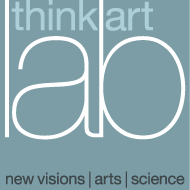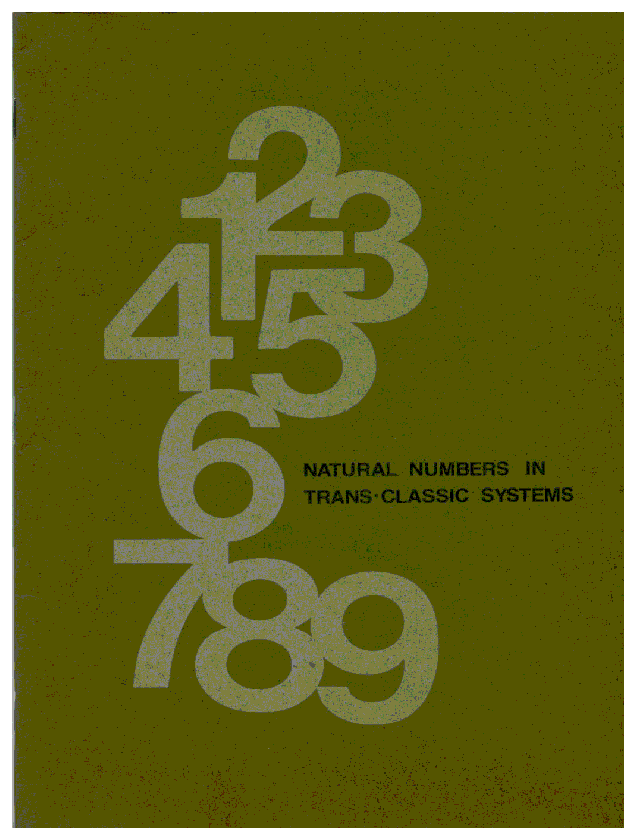
NATURAL NUMBERS IN TRANS-CLASSIC SYSTEMS

NATURAL NUMBERS IN TRANS-CLASSIC SYSTEMS
*1)
Part II of this essay was written before Part I and offered to the Third Annual Symposium of the American Society for Cybernetics as a topic of discussion. However, owing to unforeseen circumstances, the paper was not presented at the Symposium. This turned out to be a blessing in disguise. In order to conform to the time limit for oral presentation Part II was written in a highly condensed manner and there was no opportunity to elaborate on the general epistemological aspect which served as the starting point for the intended confrontation between natural numbers and structural systems of higher complexity than our traditional logic offers. We are determined to make up for this omission in Part I because we believe that the theoretical goal of Part II will be better understood if the present author clarifies his attitude toward the basic concept of organism and its mathematical treatment in cybernetic research.
To begin with let us state that what this author has been doing for many years runs counter to the professed aims in cybernetic research. When Norbert Wiener defined cybernetics as research into "the essential unity of the set of problems centering about communication, control, and statistical mechanics, whether in the machine or living tissue," then such investigations as the present one, based on trans-classic theories of logic and ontology, run on exactly the opposite track. Theories of trans-classic logic and many-valued ontologies are introduced for the very purpose of showing not the "essential unity" but the essential differences in the concept of a machine and what Wiener called the living tissue. This is crass heresy in the High Church of Cybernetics. So far the thesis of the essential ontological difference between what is traditionally called a machine and what is called a living organism has been largely ignored and this policy of leaving out of sight the intrinsic conceptual distinction between Life and an inanimate mechanism received a strong impulse when Norbert Wiener published his book Cybernetics. But Wiener's work starts, as is well known, with a chapter called "Newtonian and Bergsonian Time". This chapter already contains - despite the intent of its author - elements which cast heavy doubt on the theory of the essential unity of the set of problems which involve the machine as well as the living tissue. It is highly significant that Wiener's confrontation of Newtonian and Bergsonian time was not seriously followed up in subsequent research, and, in fact, this author remembers that one reviewer remarked about Wiener's book that he considered the essay on Newtonian and Bergsonian time quite superfluous and that Wiener might as well have started the presentation of his case with Chapter 11 which discusses Groups and Statistical Mechanics. In this paper exactly the opposite position will be taken and we want to point out that Wiener's distinction in the concept of Time leads to two different conceptual interpretations of the phenomenon which is called living tissue or organism or more generally Life.
It is a very old insight, gained already in Greek philosophy, that the phenomenon of Life is "dialectical". Plato explains what is meant by this term. If something has dialectical character it is impossible to find for it a theory in principle capable of full formalization. It will be necessary to develop two complementary theories for it which are, in a certain way, incompatible with each other (e.g., the corpuscular and wave interpretation of Matter) but which are both necessary for an exhaustive description of the phenomenon.[21]
Present cybernetics, so far, has completely disregarded the dialectical aspects of the organism and concentrated in an entirely undialectic fashion on only one of the complementary aspects which the phenomenon of living tissue or of an organism incorporates. In the following pages we shall sketchily describe both of the two aspects accentuating their incompatibility and we shall begin with the one that has been one-sidedly favored by present day cybernetics.
An organism has, in the prevailing tradition, been described as something embodying a higher and more integrated unity than a mere classic mechanism which is a loose and partly arbitrary aggregation of anorganic parts. It has been said that an organism is dominated by the principle of superadditivity, meaning that it is essentially more than the sum of all its parts. This theory has sometimes been labeled as holism and the Oxford Dictionary defines the term as referring to a "tendency in nature to form wholes that are more than the sum of the parts by creative evolution." This provokes at once the question: If this is true for the evolutive time dimension of organisms (which corresponds roughly to Newtonian time), what about the complementary emanative time dimension?[32] The epistemological assumption of holism seems to exclude that emanative developments will also drift toward superadditivity. On the other hand, one cannot have evolution without emanation and vice versa. This is structurally impossible. At any rate, the traditional concept of organism considers organic systems as things which result from a tendency to integrative togetherness with a mutual inhesion of parts tending to obliterate the identity of the part in favor of the reinforced identity of what is called the whole.
It should be pointed out that this holistic concept of organism which stresses the aspect of unity is in a significant agreement with the tradition of classic ontology. It will be useful to remind the reader that classic ontology is essentially monism: It considers the ultimate substratum of reality as one-valued. It follows for this type of philosophy that the deeper we understand a phenomenon the more we will strive to see in it unity, continuity, homogeneity, and harmony. This is the classic scientific way into the depth dimension of Reality � leading ultimately into the coincidentia oppositorum of Nicholas of Cues. The concept of universal Being which unites and reconciles the opposites is nothing if not the expression of the belief that the whole Universe represents to us the aspect of an unbroken context of objective existence. It is inevitable that in this climate of thinking the organism appears as a marvel of integration and of a prestabilized harmony. Life, for the classic thinker, is the blessed state in which the parts of the Universe "know" each other in the sense in which the Bible uses the term in Chapter IV of Genesis: "And Adam knew his wife." The coincidentia oppositorum is maximal superadditivity.
The one-sidedness of this epistemological attitude is revealed when we look at one of the highest triumphs of cybernetics. Thanks to an early paper of Warren McCulloch and Walter Pitts, we know that any property of an organism which we can define in finite and non-ambiguous terms can be repeated and duplicated in a nonorganic "classic" machine. [43] And let us not forget that all our nonorganic hardware has grown out of theories based on classic mathematics, two-valued logic and one-valued ontology. With this reminder let us have a look at the consequences of the McCulloch/Pitts discovery.
It has been said by philosophic pragmatism that we can only understand what we make. But we might also say, and with equal right, that if we can build a machine which displays-let us say-all possible behavioral traits of memory, then we have dispensed from a technical viewpoint with the necessity to understand what memory is in a living person. We know that in a living person memory establishes personal identity lasting through a given span of time; but no cyberneticist has ever seriously asserted that, if we have designed "I memory" into a piece of hardware, we have infused the latter with a sense of personal identity. It is also nonsensical to think that, with the present methods of improving the memory functions of computers, we can even approach the total role the Platonic Anamnesis plays in a living system. Cybernetics as a technical discipline does not even aim at repeating an organism itself in hardware, it only aims at repeating observable behavioral traits of organisms. It is totally indifferent to the problem of whether such behavioral traits occur in an animated biological system or in an inanimate classic mechanism - and whether such difference of locality may produce a different hermeneutic[54] significance for otherwise totally identical traits. The most important epistemological lesson that can be learned from the McCulloch-Pitts paper is that it defines - quite unintentionally but sharply - the boundary between cybernetics as a basic hermeneutic science which wants to understand the phenomenon of Life and cybernetics as a science of sophisticated mechanics which reaches for the technical know-how to imitate the results which organisms achieve within the objectively observable section of Reality. On the other hand, the process by dint of which memory contributes to the establishment of self-referential personal identity within a living person does not belong to the field of the objectively observable, which means we cannot imitate it. Being technically imitable and being on principle observable are, epistemologically speaking, synonymous terms. Thus the McCulloch-Pitts paper indirectly opens up a field of as yet untouched hermeneutic cybernetics where this novel discipline does not want to repeat and imitate living systems as a feat of hardware or even software engineering, but where we strive to understand what is left after the engineer has done his work.
The shortcomings of the present one-sided trend of cybernetic research make themselves felt especially when we consider the fact that cybernetic methods have made deep inroads into the Humanities, investigating, for example, problems of literature with statistical methods. It stands to reason that the cyberneticist will play his games merely on the surface of the Humanities if he ignores the hermeneutic approach of understanding what is already known in a merely factual sense. The traditional hermeneutic methods, however, fail because their incompatibility with the requirements of exact algorithms as they are now used in cybernetics is too great. What is urgently required is an algorithmetization of hermeneutics. Such algorithmetization would fall within the domain of transcendental logic. But-although cybernetics so far has completely ignored transcendental logic - the great irony is that it has willingly adopted a fateful prejudice to which the instigators of transcendental logic (Kant, Fichte, and Hegel) paid homage. It is the seemingly unshakeable prejudice that hermeneutical processes are entirely incapable of formalization.[65]
Unfortunately, we cannot raise the demand for hermeneutic understanding in addition to factual knowing without having the dialectical issue emerge again. It must be understood that hermeneutics has no field for its interpreting activity unless a problem has been formulated in such a way that any attempt at its solution forces us to develop mutually incompatible but strictly complementary theories.
A dialectic theory of organism, based on the principle of conceptual complementarity, has not yet been developed. We have pointed out that cybernetics, up to now, has favored an entirely one-sided nondialectical concept of organism, obtaining remarkable but equally one-sided results. These results have already had a considerable impact on present society. But since their one-sidedness and concomitant social ambivalence has not yet been clearly recognized, computer theory has, sociologically speaking, proved a limited boon but to a much greater degree a calamity.
We have characterized the holistic viewpoint of organism as one where everything seems to gravitate toward a center of self-referential integrative identity with its relative reconciliation of the opposites which produces a precariously balanced superadditive unity. We shall now describe the complementary aspect of living systems which reveals itself in the intrinsic dishomology of incompatible elements straining away from each other and drifting towards dissolution of the w